
For the last two weeks the market has really been pounding at the low set at the end of September. It even broke below that low intraday on Thursday, but closed above it. In the meantime, participation has been improving with the Stocks Above 20/50/200-day EMAs moving higher, implying that maybe those price lows are going to hold. While we currently have a bearish outlook, the market has been known to hit important lows in October, and it is best that we don't overlook these sneaky little bullish signals.

The DecisionPoint Alert Weekly Wrap presents an end-of-week assessment of the trend and condition of the Stock Market, the U.S. Dollar, Gold, Crude Oil, and Bonds. The DecisionPoint Alert daily report (Monday through Thursday) is abbreviated and gives updates on the Weekly Wrap assessments.
Watch the latest episode of DecisionPoint on StockCharts TV's YouTube channel here!
MAJOR MARKET INDEXES
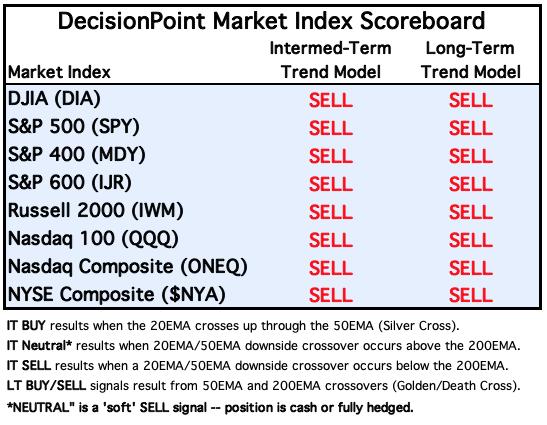
For Today: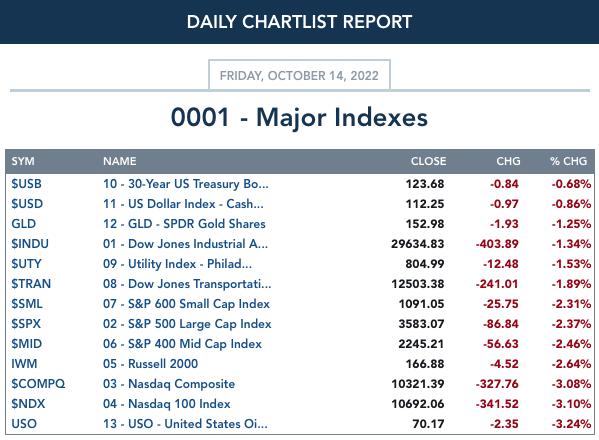
For the Week:
SECTORS
Each S&P 500 Index component stock is assigned to one of 11 major sectors. This is a snapshot of the Intermediate-Term (Silver Cross) and Long-Term (Golden Cross) Trend Model signal status for those sectors.
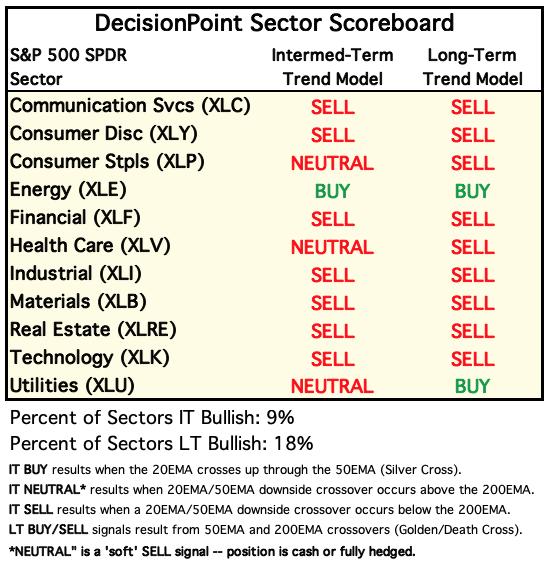
For Today: 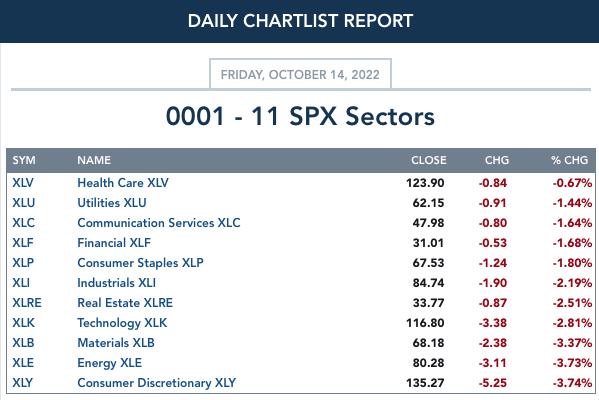
For the Week: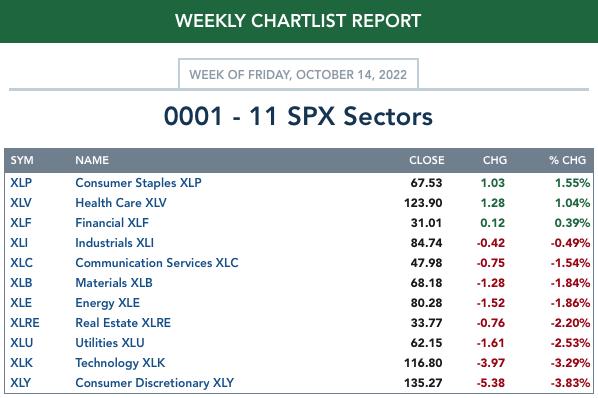
RRG® Daily Chart ($ONE Benchmark):
XLE is the clear winner on the RRG. It is the only one on the right half of the RRG (meaning it has a bullish configuration) and is well into the Leading quadrant.
Most bearish is XLY which is languishing in the Lagging quadrant. XLU is also Lagging but at least it is headed northward toward Improving.
With the exception of XLB, all of the sectors within the Improving quadrant have bullish northeast headings that could take them into the Leading quadrant. All is not lost for XLB as it still has an easterly component to its heading.
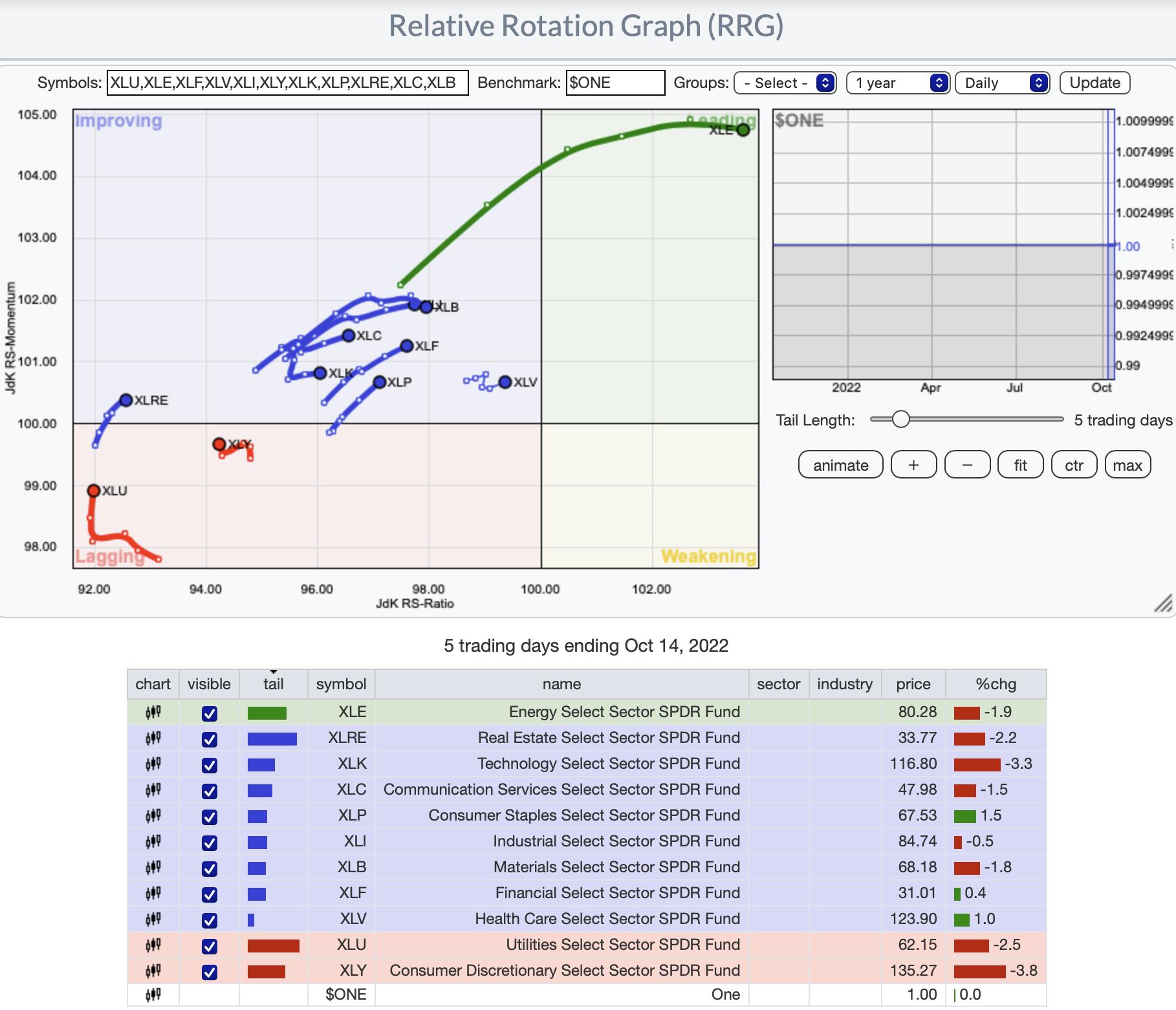
RRG® Weekly Chart ($ONE Benchmark):
The weekly RRG is not at all encouraging. XLE and XLU are on the right side of the RRG meaning a bullish configuration. However, XLU should find itself in the Lagging quadrant very soon. XLF and XLY are the only members of the Improving quadrant, but they too are very close to reaching the Lagging quadrant.
The remainder of sectors are in the Lagging quadrant holding bearish southwest headings that will take them deeper into the bearish Lagging quadrant.
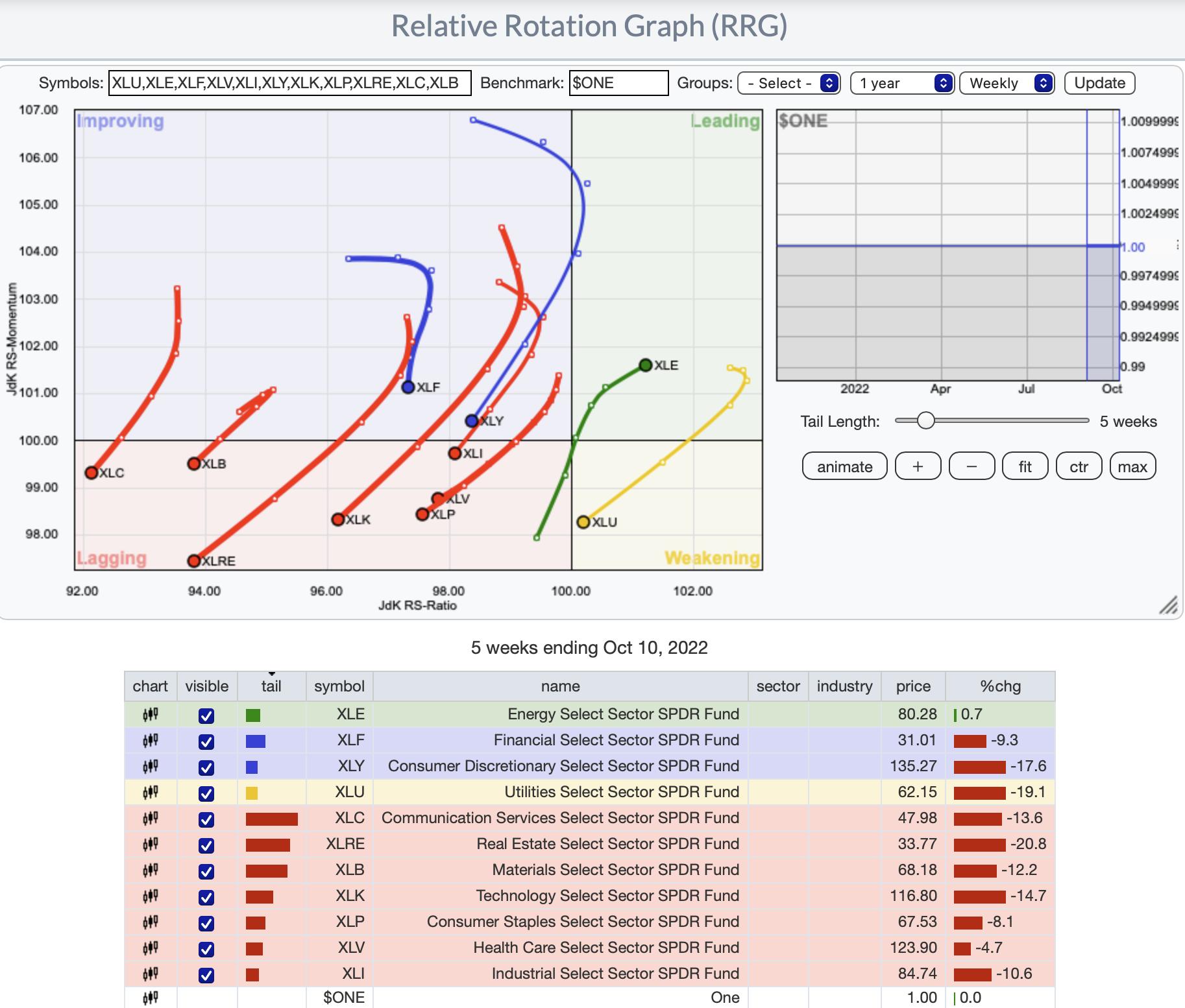
RRG® charts show you the relative strength and momentum for a group of stocks. Stocks with strong relative strength and momentum appear in the green Leading quadrant. As relative momentum fades, they typically move into the yellow Weakening quadrant. If relative strength then fades, they move into the red Lagging quadrant. Finally, when momentum starts to pick up again, they shift into the blue Improving quadrant.
CLICK HERE for an animated version of the RRG chart.
CLICK HERE for Carl's annotated Sector charts.
THE MARKET (S&P 500)
IT Trend Model: SELL as of 9/8/2022
LT Trend Model: SELL as of 5/5/2022
SPY Daily Chart: We now have a clearly defined bullish falling wedge on the SPY. Indicators are that healthy given the RSI is negative and falling and the PMO topped beneath its signal line. The VIX is also oscillating below its moving average suggesting internal weakness.

The OBV continues lower with no positive divergence in sight (rising bottoms to price's declining bottoms). Stochastics are rising. They are more sensitive than the PMO and could be signaling a possible reversal ahead.

SPY Weekly Chart: The declining tops trendlines has accelerated lower as this last bear market drop was a doozy (technical term of course :)) Support has been met at the 2020 tops after the 2020 bear market. Strongest support lies and the top before the 2020 bear market decline. We would expect price to worm its way down to that level given the negative configuration of the weekly PMO.

New 52-Week Highs/Lows: We negligible New Highs and New Lows as the market took back half of yesterday's gains. We do note the whipsaw reversal on the 10-DMA of the High-Low Differential, but nothing good has really happened since it bottomed--we saw two up days amongst multiple down days. This whipsaw could bode but we're cautious.
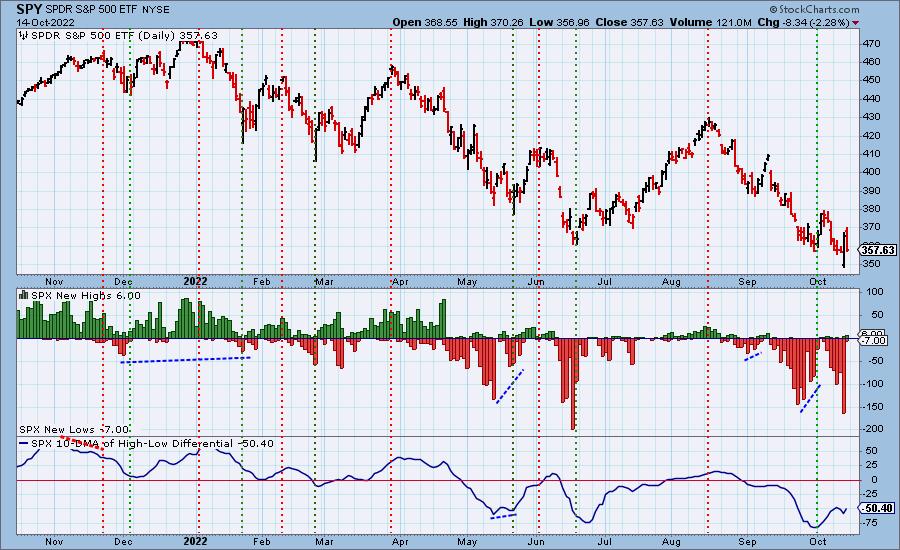
Climax Analysis: Yesterday there was a strong upside initiation climax, but, as we often point out, climaxes are basically exhaustion events. So while the price reversal tagged the climax as an initiation, exhaustion also occurred. Today we got a fairly strong downside initiation climax, which basically nullifies yesterday's climax.
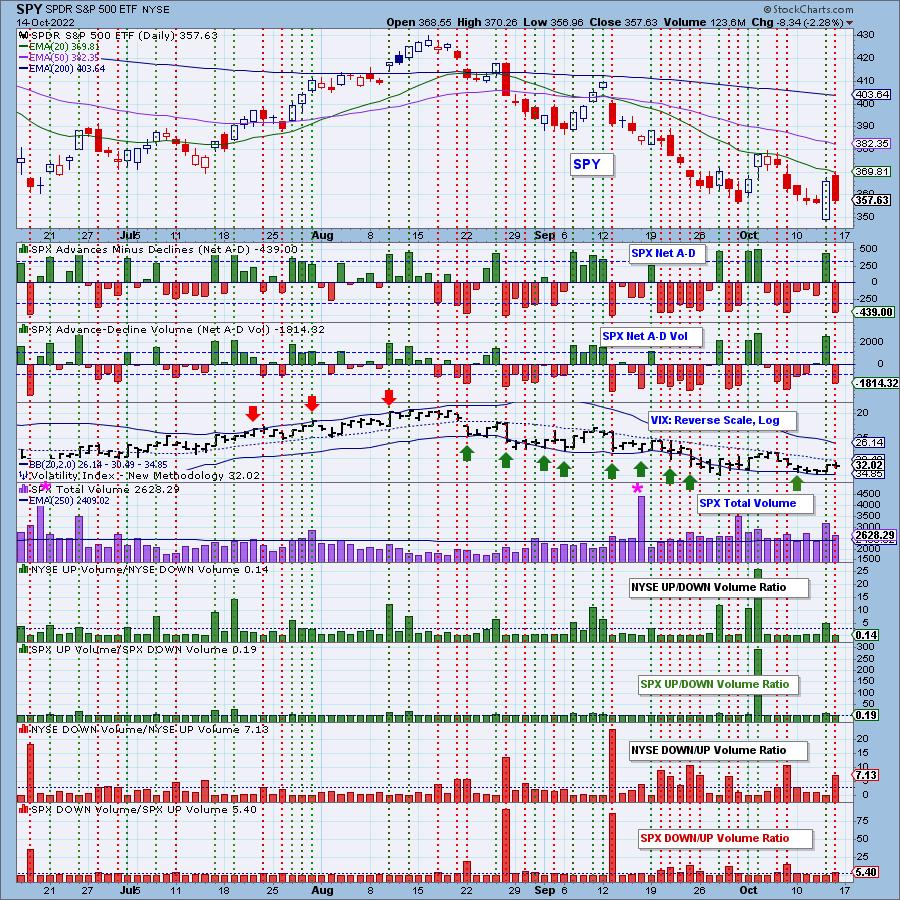
*A climax is a one-day event when market action generates very high readings in, primarily, breadth and volume indicators. We also include the VIX, watching for it to penetrate outside the Bollinger Band envelope. The vertical dotted lines mark climax days -- red for downside climaxes, and green for upside. Climaxes are at their core exhaustion events; however, at price pivots they may be initiating a change of trend.
Short-Term Market Indicators: The short-term market trend is DOWN and the condition is OVERSOLD.
On this chart there are numerous positive divergences that echo the positive picture we discussed at the beginning of this commentary.
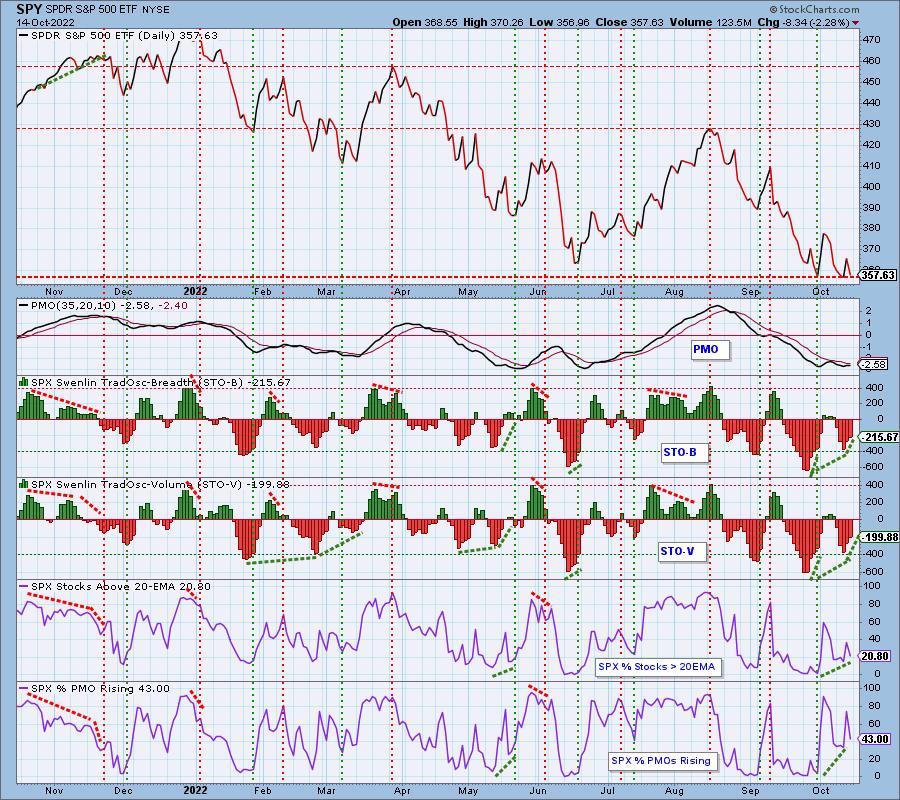
Intermediate-Term Market Indicators: The intermediate-term market trend is DOWN and the condition is OVERSOLD.
The ITBM and ITVM are very oversold in the long term, and they have short-term positive divergences.
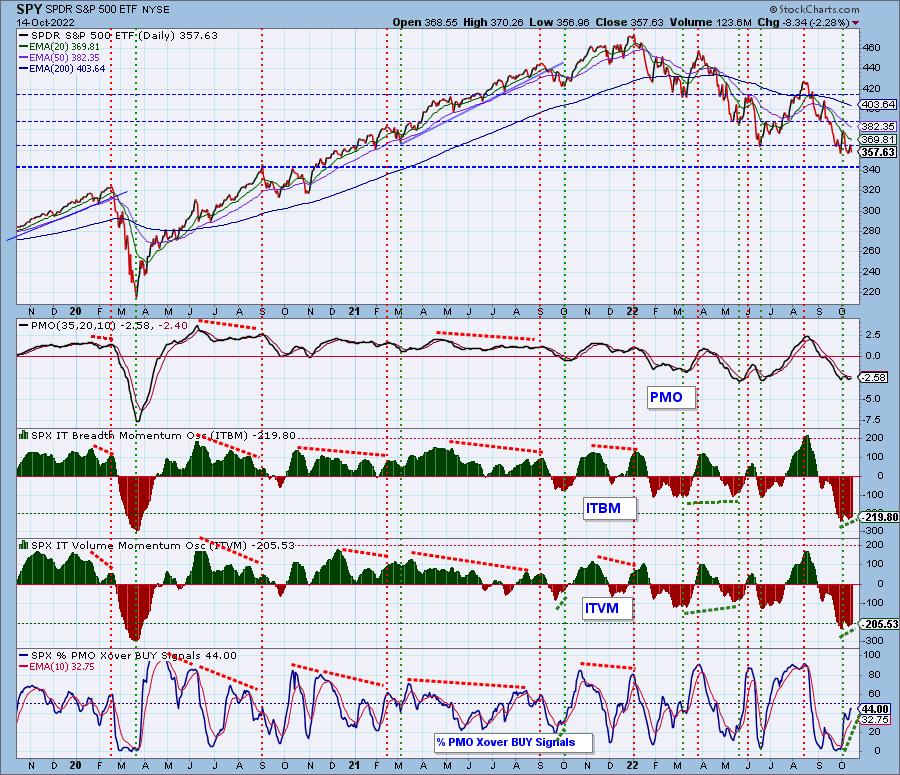
PARTICIPATION and BIAS Assessment: The following chart objectively shows the depth and trend of participation in two time frames.
- Intermediate-Term - the Silver Cross Index (SCI) shows the percentage of SPX stocks on IT Trend Model BUY signals (20-EMA > 50-EMA). The opposite of the Silver Cross is a "Dark Cross" -- those stocks are, at the very least, in a correction.
- Long-Term - the Golden Cross Index (GCI) shows the percentage of SPX stocks on LT Trend Model BUY signals (50-EMA > 200-EMA). The opposite of a Golden Cross is the "Death Cross" -- those stocks are in a bear market.
The following table summarizes participation for the major market indexes and sectors. The 1-Week Change columns inject a dynamic aspect to the presentation.
Only the Energy Sector has readings in the bull market range (50 or above).

This table is sorted by SCI values. This gives a clear picture of strongest to weakest index/sector in terms of participation.
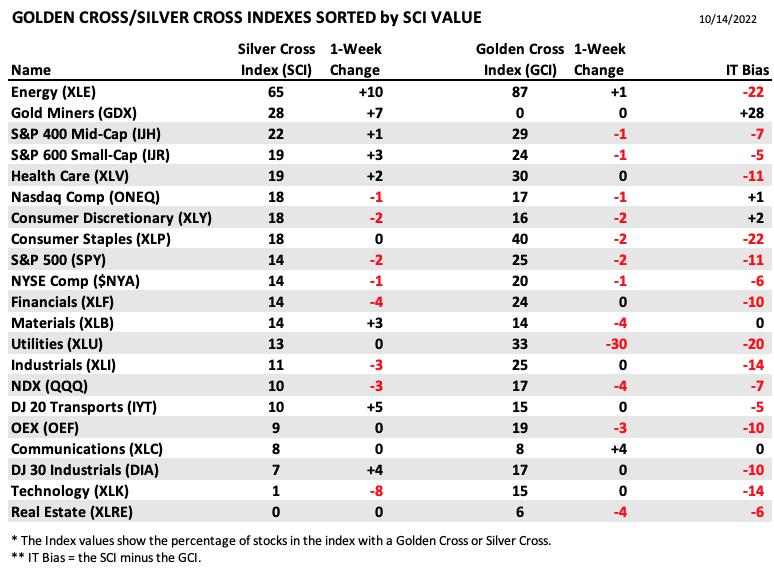
PARTICIPATION and BIAS Assessment: The following chart objectively shows the depth and trend of participation in two time frames.
- Intermediate-Term - the Silver Cross Index (SCI) shows the percentage of SPX stocks on IT Trend Model BUY signals (20-EMA > 50-EMA). The opposite of the Silver Cross is a "Dark Cross" -- those stocks are, at the very least, in a correction.
- Long-Term - the Golden Cross Index (GCI) shows the percentage of SPX stocks on LT Trend Model BUY signals (50-EMA > 200-EMA). The opposite of a Golden Cross is the "Death Cross" -- those stocks are in a bear market.
The bearish short-term bias is deteriorating, particularly given we have positive divergences of %Stocks > 20/50-day EMAs.
The intermediate-term bias is still bearish given the low reading on the SCI and its flat appearance.
The long-term bias is beginning to see some improvement, but we will consider it bearish given the low reading on the GCI and %Stocks > 50/200-day EMAs being less than the GCI.
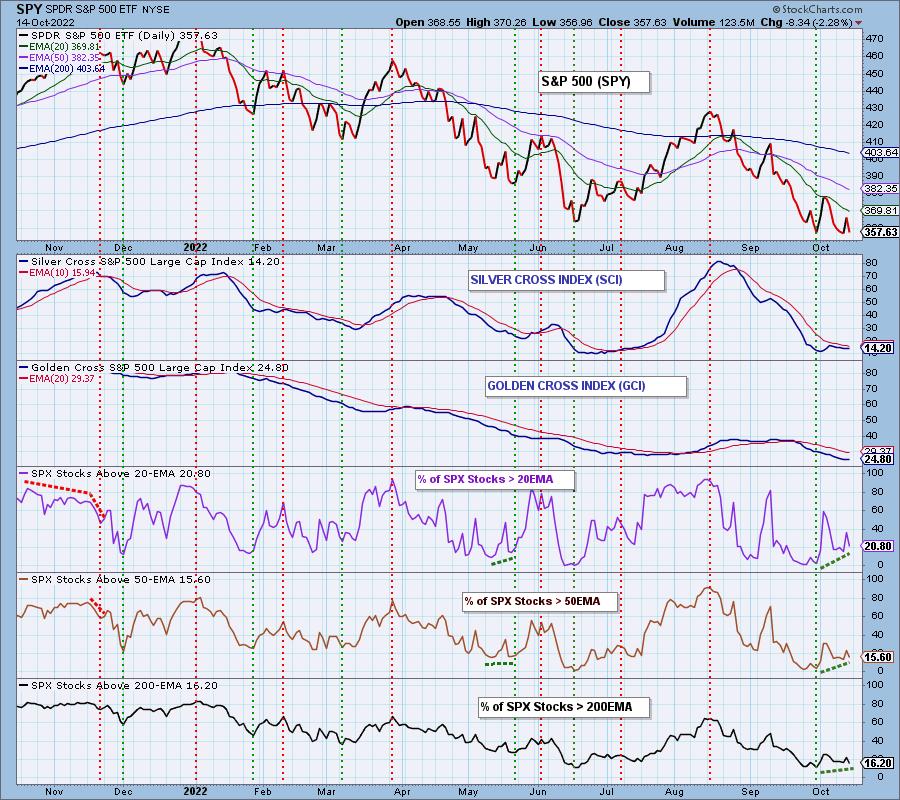
CONCLUSION: We began this commentary recognizing the positive divergences showing up on the Stocks Above 20/50/200-day EMAs chart. More of them showed up on the short-term STO chart. The Intermediate-term ITBM and ITVM are very oversold, and they also have positive divergences. It is mid-October, and we are approaching the start of the 6-month period of favorable seasonality. On top of all that, sentiment is screaming for a bullish outcome. The current decline may very well continue, but let's not be too surprised if things suddenly turn positive for a while.
Calendar: Next week is options expiration. Expect low volatility and normal volume toward the end of the week.
Have you subscribed the DecisionPoint Diamonds yet? DP does the work for you by providing handpicked stocks/ETFs from exclusive DP scans! Add it with a discount! Contact support@decisionpoint.com for more information!
BITCOIN
Bitcoin is in an intermediate-term declining trend. It is mainly traveling in a trading range between $18,00 and $20,000. With indicators flat or mostly unresponsive, we would look for more oscillation within this range.
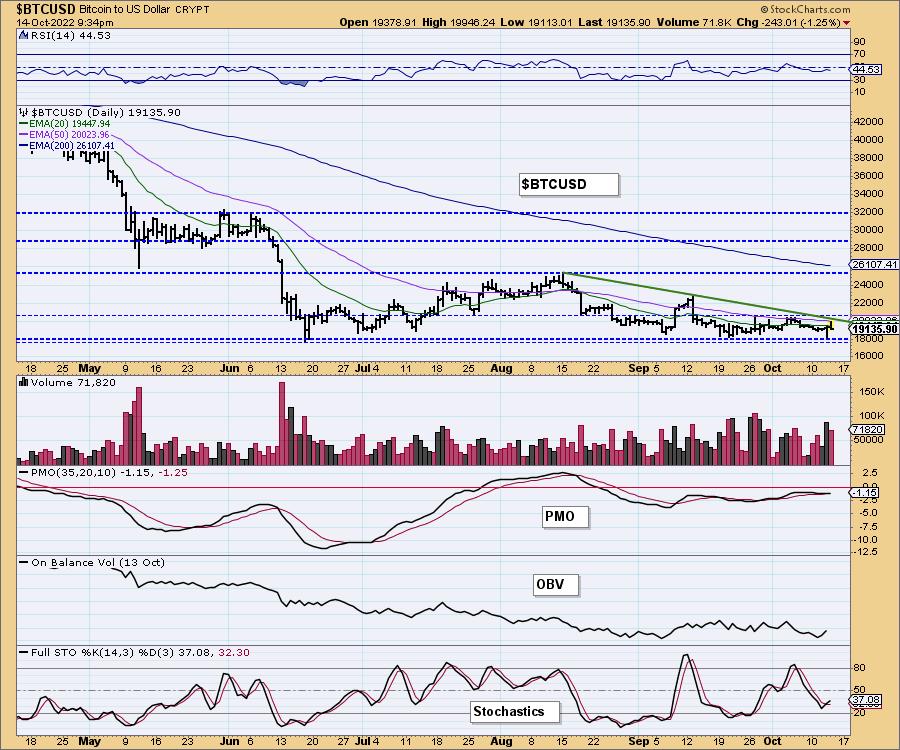
This chart is to show where some of the support/resistance lines come from.
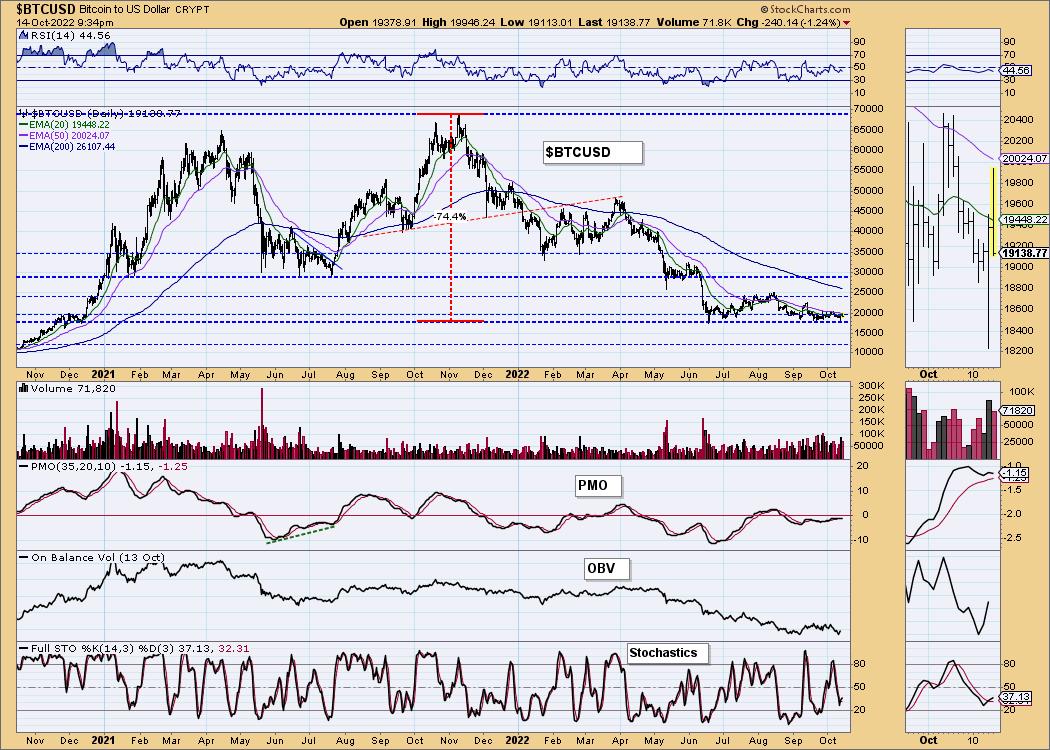
INTEREST RATES
There was a common thought amongst market makers that yields were ready to top. Not so much. They continue to make multi-year highs.
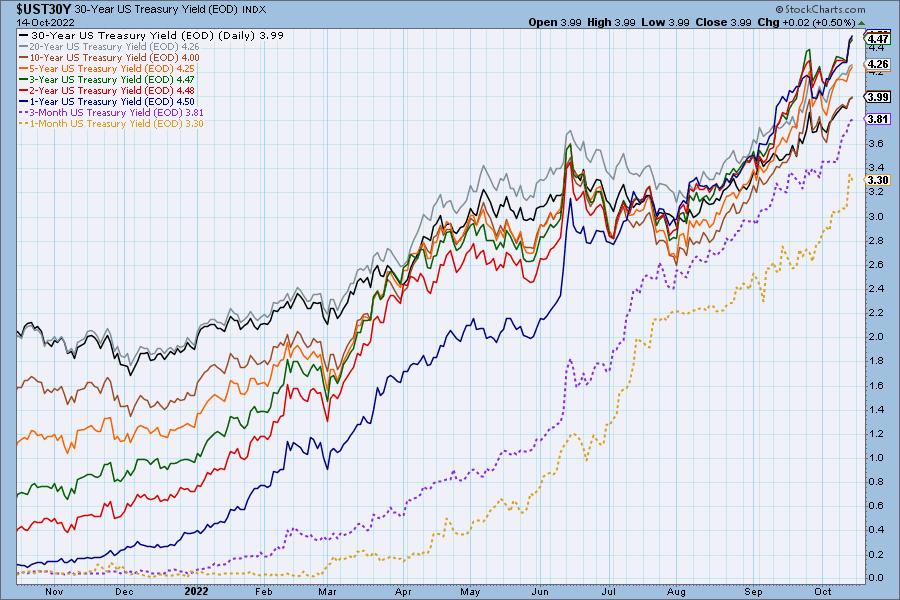
The Yield Curve Chart from StockCharts.com shows us the inversions taking place. The red line should move higher from left to right. Inversions are occurring where it moves downward.
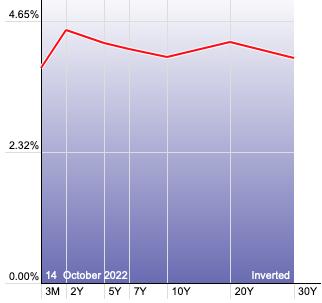
10-YEAR T-BOND YIELD
$TNX closed on resistance. Given it didn't have to test the rising trend before breaking out, we would look for it to have a more meaningful breakout above resistance. The PMO and Stochastics are flat and revealing nothing. The RSI is positive but about to reenter overbought territory again.
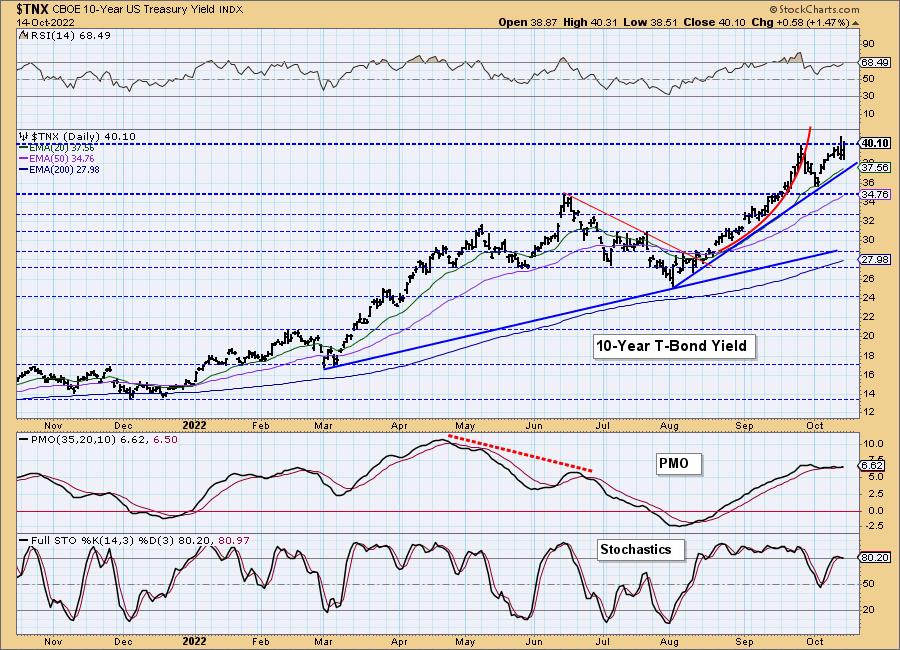
MORTGAGE INTEREST RATES (30-Yr)**
**We watch the 30-Year Fixed Mortgage Interest Rate, because, for the most part, people buy homes based upon the maximum monthly payment they can afford. As rates rise, a fixed monthly payment will carry a smaller mortgage amount. As buying power shrinks, home prices will come under pressure.
--
This week the 30-Year Fixed Rate rose from 6.66 to 6.92.
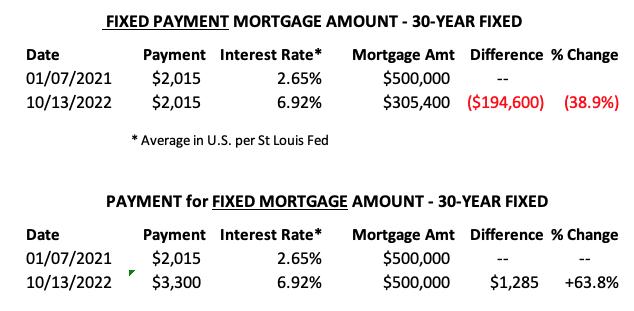

DOLLAR (UUP)
IT Trend Model: BUY as of 6/22/2021
LT Trend Model: BUY as of 8/19/2021
UUP Daily Chart: The Dollar finished higher, but it still looks toppy and ready to test the short-term rising bottoms trendline. The PMO and Stochastics are flat, but the RSI is positive.
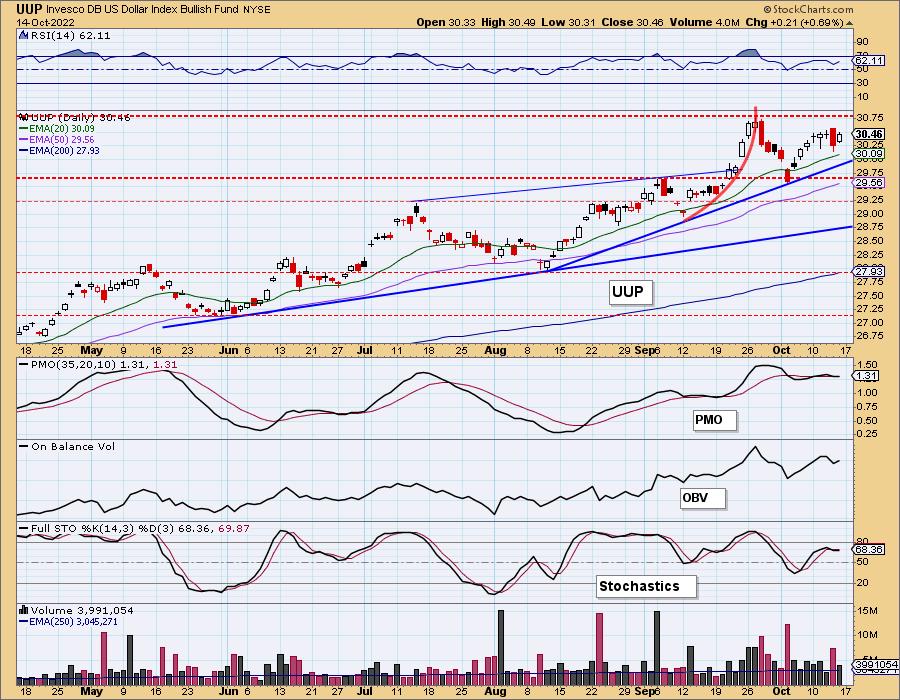
If we do see a decline, it will set-up a bearish double-top.
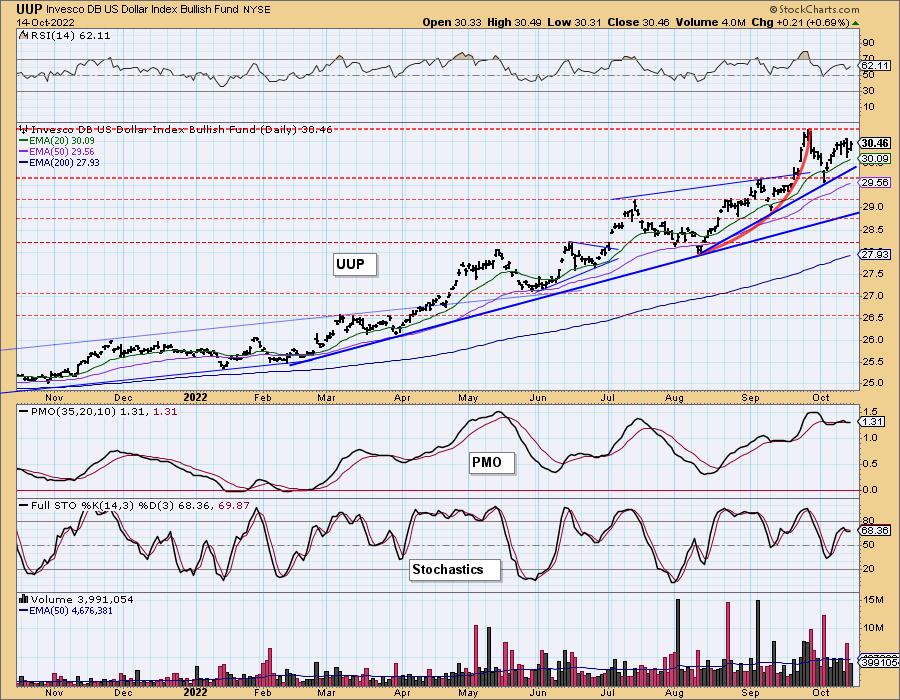
UUP Weekly Chart: We're seeing a parabolic advance on UUP. These eventually breakdown in spectacular fashion. While we don't see enough weakness on this chart, we should nonetheless be aware of the bearish implications. It is certainly extended and overbought.
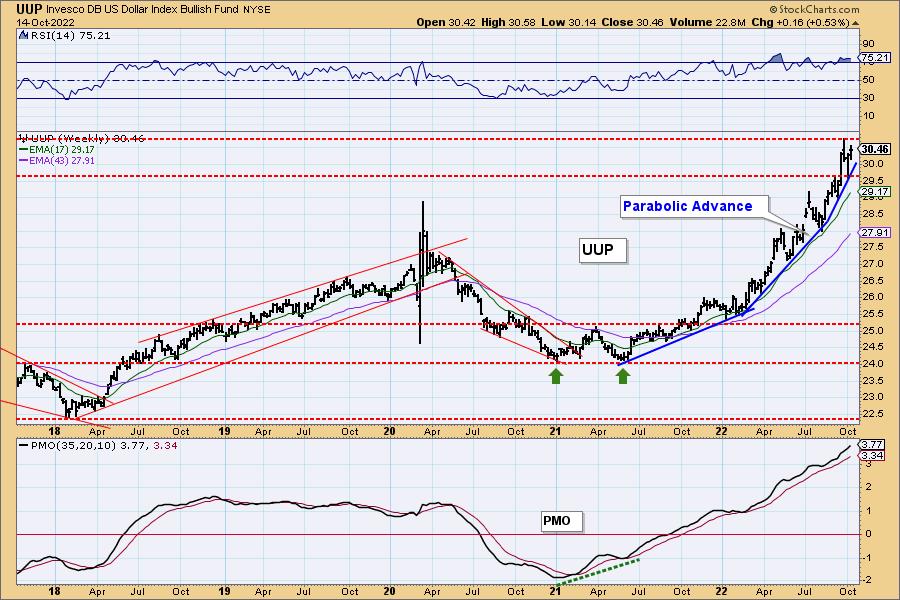
GOLD
IT Trend Model: NEUTRAL as of 5/3/2022
LT Trend Model: SELL as of 6/30/2022
GOLD Daily Chart: The Dollar needs to reverse or Gold is going to continue to push lower. Indicators are quite negative with the PMO about to trigger a crossover SELL signal, the RSI is negative and falling, and Stochastics are headed lower.
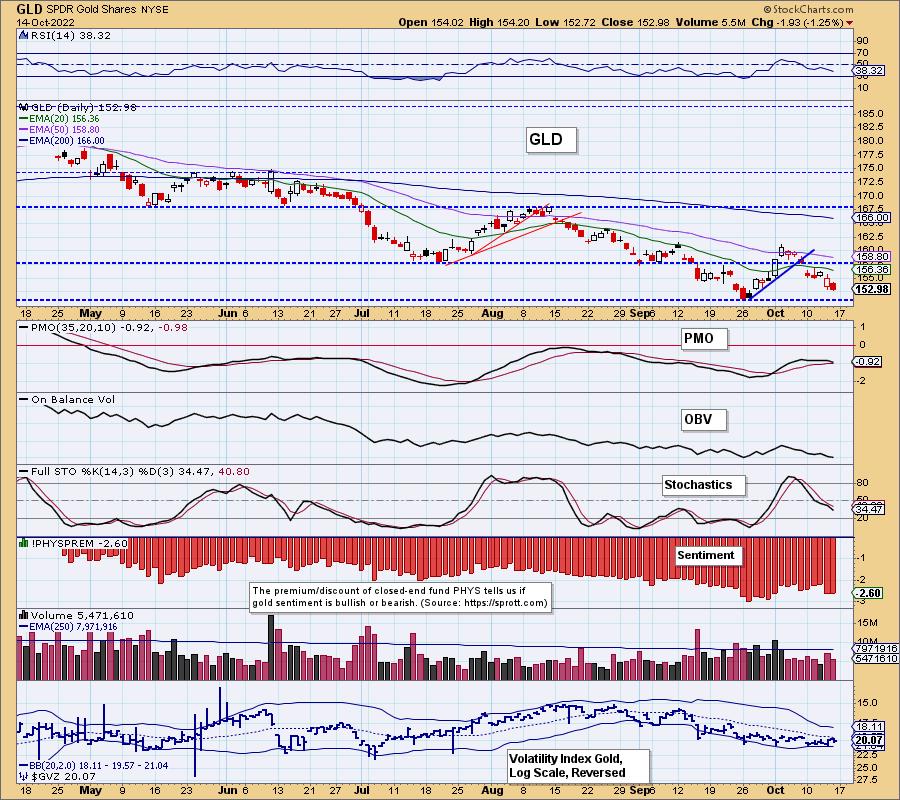
Discounts are back to historically high readings meaning investors are extremely bearish on Gold. Generally sentiment is contrarian, but that hasn't played out yet for Gold. It looked like we had a strong rally at the end of September only to see it fail miserably this month.
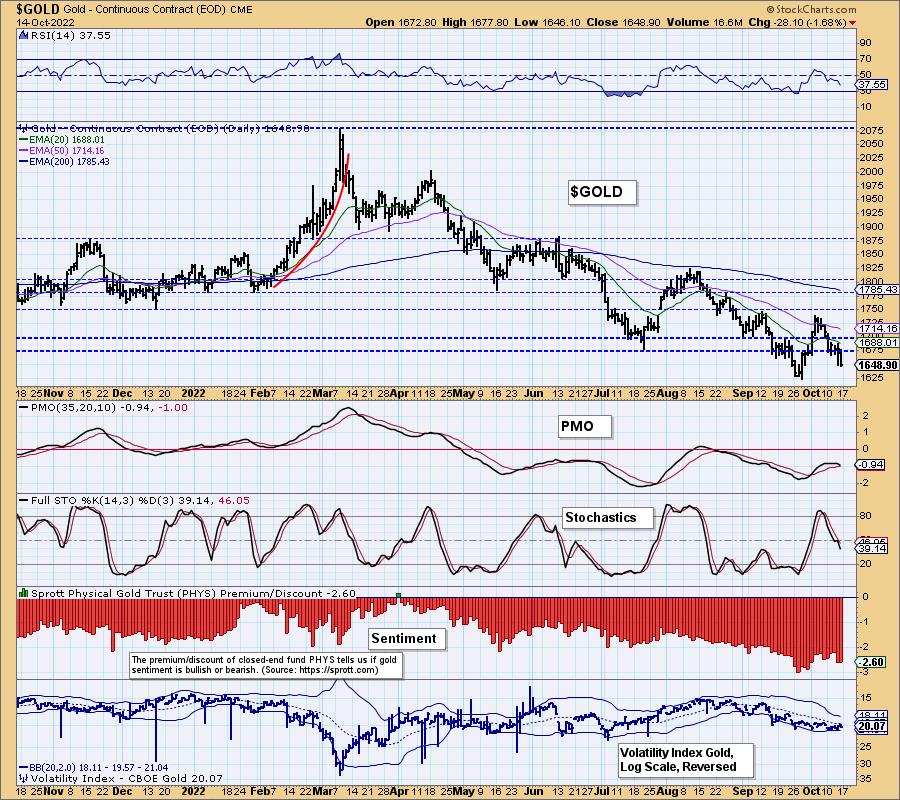
GOLD Weekly Chart: The long-term rising trend was compromised last month. Support is holding at the late 2019 top, but the stronger area of support is below that at the 2019 high. There is an ominous double-top that technically was confirmed in September when price broke support at $1650. The weekly RSI is falling in negative territory and the weekly PMO has bearishly topped beneath the signal line. Gold has further to fall.
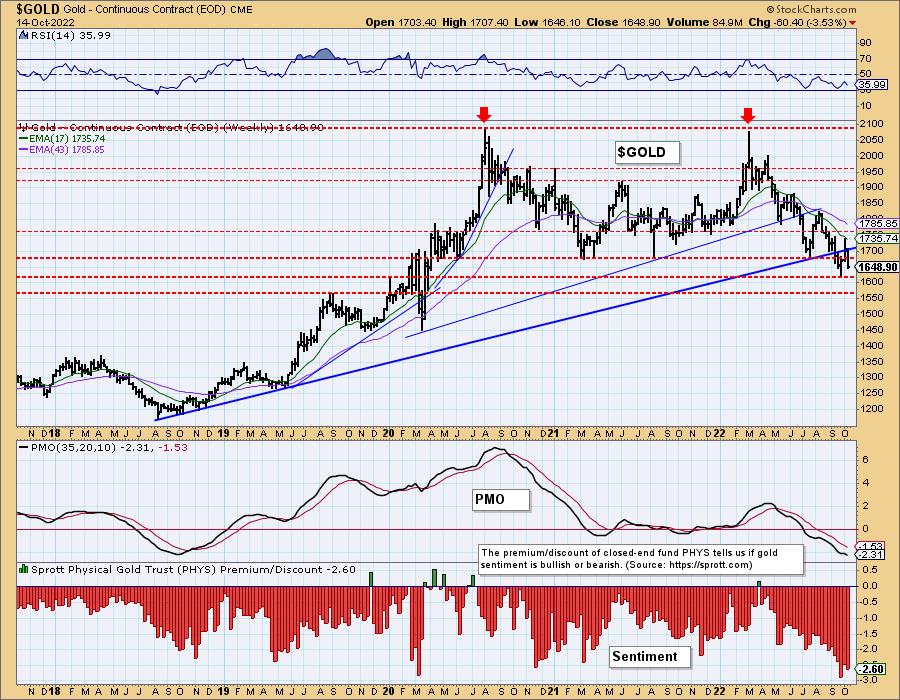
GOLD MINERS Golden and Silver Cross Indexes: Gold Miners have given it up. We now have zero stocks above their 20-day EMA and the SCI has topped. The hope had been that we'd see a reversal here and that would form a reverse head and shoulders. At this point, look for a test and likely failure at the September low.
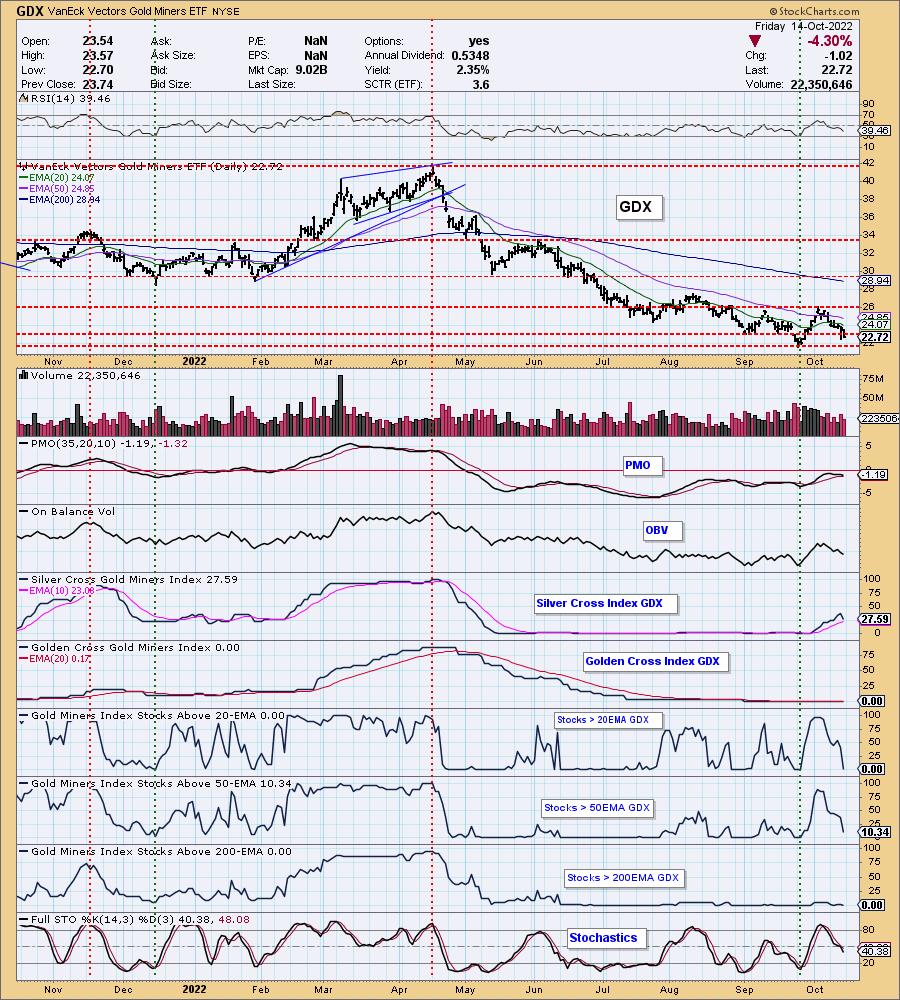
CRUDE OIL (USO)
IT Trend Model: NEUTRAL as of 7/8/2022
LT Trend Model: BUY as of 3/9/2021
USO Daily Chart: USO is forming a bull flag and so far hasn't entered its prior declining trend. It's trying to and indicators are beginning to soften. The RSI just dropped beneath net neutral (50) and the PMO is topping beneath the zero line. Stochastics are also falling.

The $OVX is above its moving average, but given the Bollinger Bands are so close together, we should see a puncture of the upper Band soon. That would be bearish for USO.
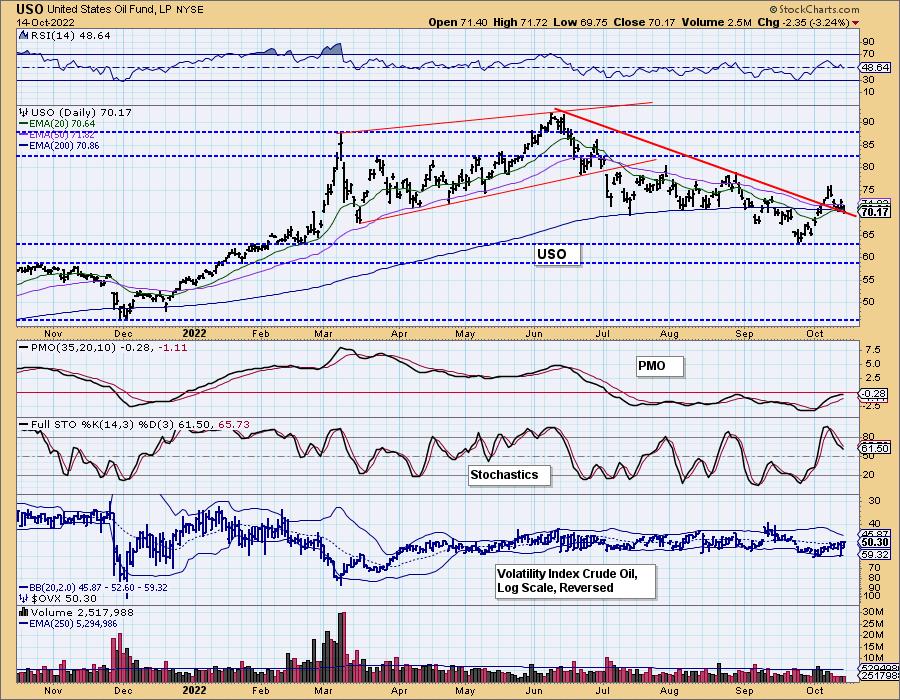
USO/$WTIC Weekly Chart: The long-term rising trend is intact and price is bouncing off it. The weekly RSI is bearish, but the weekly PMO has decelerated and could turn back up above the zero line which would be very bullish. We're not there yet. $WTIC hit overhead resistance and immediately turned lower. Crude Oil is on the cusp of something very good or something very very bad.
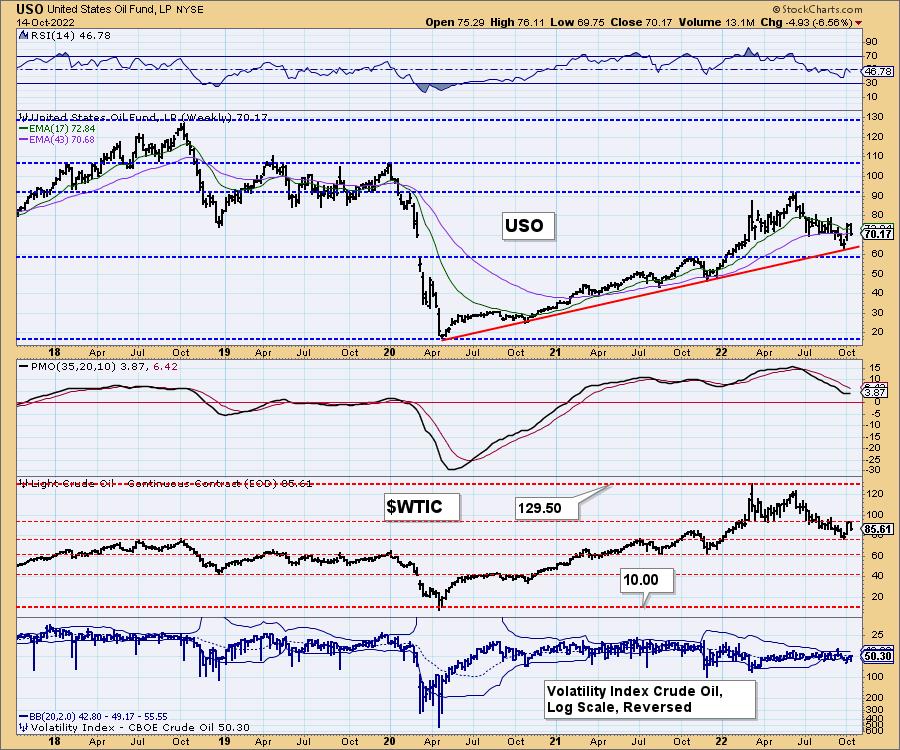
BONDS (TLT)
IT Trend Model: SELLas of 8/19/2022
LT Trend Model: SELL as of 1/19/2022
TLT Daily Chart: TLT continues in its declining trend as the 20-year yield continues to push it lower. All of the indicators are negative suggesting more downside ahead.
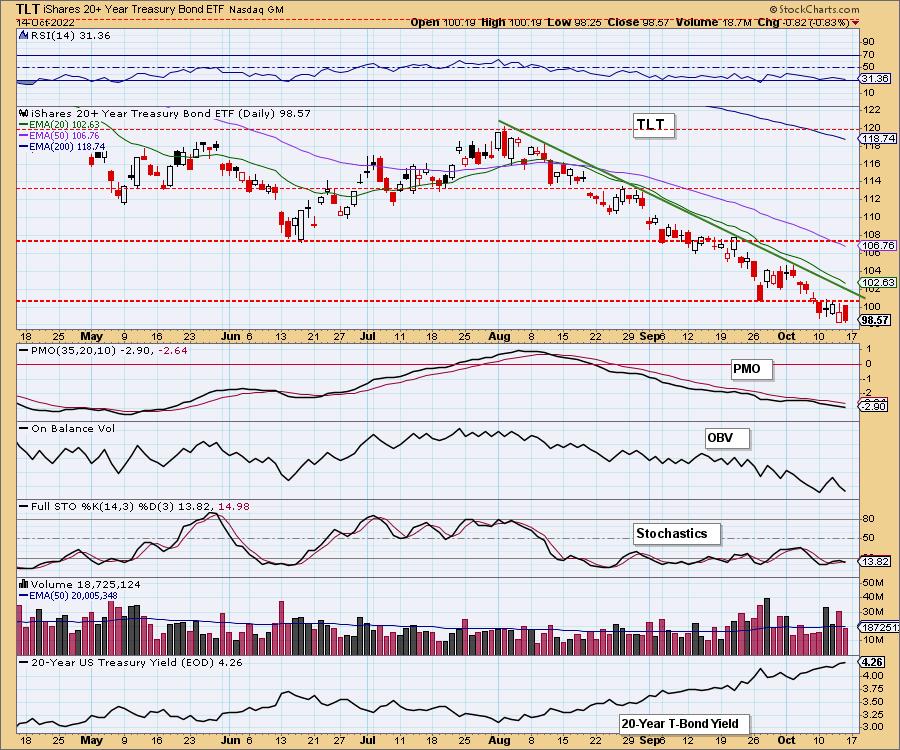

TLT Weekly Chart: Multi-year support was lost in September and it only continues to get worse. The weekly PMO and RSI are both oversold, but continue to march ever lower. We expect yields to continue to press higher and that means TLT will continue to move lower.

Good Luck & Good Trading!
Erin Swenlin And Carl Swenlin
Technical Analysis is a windsock, not a crystal ball. --Carl Swenlin
(c) Copyright 2022 DecisionPoint.com
Disclaimer: This blog is for educational purposes only and should not be construed as financial advice. The ideas and strategies should never be used without first assessing your own personal and financial situation, or without consulting a financial professional. Any opinions expressed herein are solely those of the author, and do not in any way represent the views or opinions of any other person or entity.
NOTE: The signal status reported herein is based upon mechanical trading model signals, specifically, the DecisionPoint Trend Model. They define the implied bias of the price index based upon moving average relationships, but they do not necessarily call for a specific action. They are information flags that should prompt chart review. Further, they do not call for continuous buying or selling during the life of the signal. For example, a BUY signal will probably (but not necessarily) return the best results if action is taken soon after the signal is generated. Additional opportunities for buying may be found as price zigzags higher, but the trader must look for optimum entry points. Conversely, exit points to preserve gains (or minimize losses) may be evident before the model mechanically closes the signal.
Helpful DecisionPoint Links:
DecisionPoint Alert Chart List
DecisionPoint Golden Cross/Silver Cross Index Chart List
DecisionPoint Sector Chart List
Price Momentum Oscillator (PMO)
Swenlin Trading Oscillators (STO-B and STO-V)
DecisionPoint is not a registered investment advisor. Investment and trading decisions are solely your responsibility. DecisionPoint newsletters, blogs or website materials should NOT be interpreted as a recommendation or solicitation to buy or sell any security or to take any specific action.
